The iPhone 7 and iPhone 7 Plus Review: Iterating on a Flagship
by Joshua Ho & Brandon Chester on October 10, 2016 8:00 AM EST- Posted in
- Smartphones
- Apple
- Mobile
- iOS
- iOS 10
- iPhone 7
- iPhone 7 Plus
System Performance
Section by Brandon Chester
At the heart of a smartphone lies the SoC. While there's now an increasingly common belief that specifications don't matter, the truth of the matter is that almost all of the software features that users now take for granted in a smartphone have only been made possible by the continued improvements in hardware performance. Modern smartphones with high resolution displays and complex interfaces would not exist if the available CPU and GPU processing power hadn't advanced as much as it has. On top of that, performance is something of a gating factor for software development, as the innovation that happens in software has to happen within the boundaries of what can be done with the hardware. Specifications in a smartphone actually matter quite a lot, even if the user isn't actively aware of all the individual components that make up their smartphone's SoC.
With the iPhone 7 Apple doesn't have the benefit of a new major process node to help improve performance. Any improvements will be the result of architectural improvements, as well as improvements that have been made to TSMC's 16nm process since the release of the Apple A9, which was Apple's first FinFET SoC. It's important to note that one of the goals of A10 Fusion is improving dynamic range, so the focus isn't solely on improving performance. However, device performance seemingly must improve with each generation, and Apple is advertising a 40% improvement in CPU performance and a 50% improvement in GPU performance with A10 Fusion compared to A9.
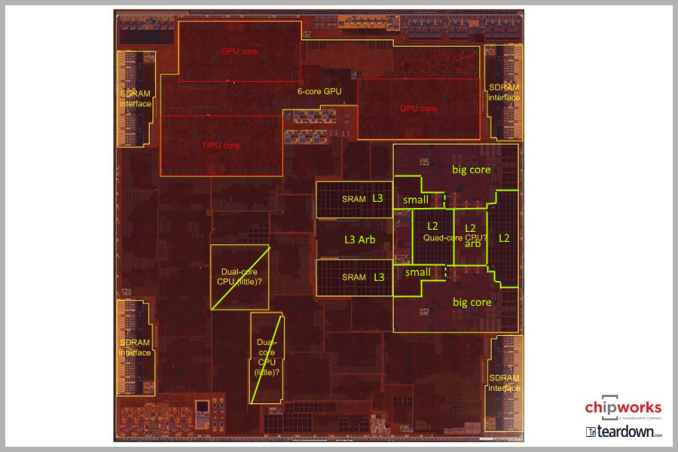
A10 Fusion's Floorplan (Special thanks to Chipworks)
While an in-depth look at A10 Fusion will have to wait until our seperate technology deep dive, we can still take a look at how performance has changed at a higher level. A10 Fusion's peak frequency is 2.3GHz, up from 1.8GHz on A9. This gives a theoretical improvement of 28% on its own, and the remainder will have to come from improvements to the architecture in Apple's (big) Hurricane cores. Based on our testing so far, Hurricane is not radically different from Twister (A9), but Apple has been making some optimizations. Meanwhile it should be noted that while A10 technically has four CPU cores – the two Hurricane cores and the two smaller cores – this is not a heterogeneous design, and only two cores are active at once. So for the purposes of high performance benchmarking, this means we're benchmarking the big cores nearly exclusively.
Anyhow, we've run our standard suite of benchmarks on the iPhone 7 and 7 Plus to see if A10 Fusion stands up Apple's performance claims.
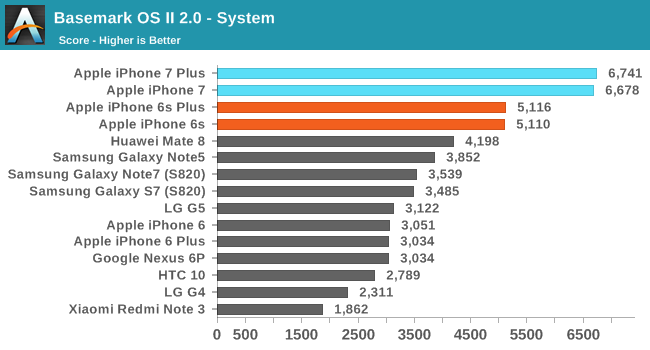
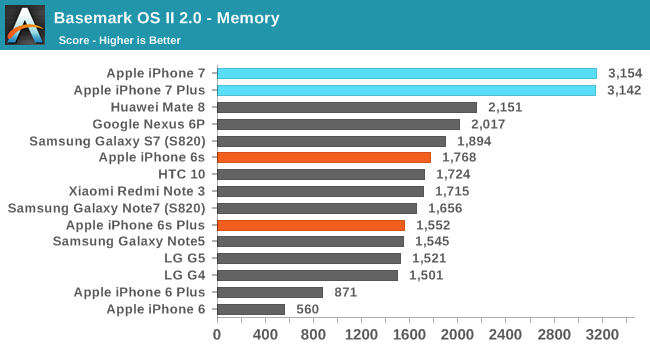
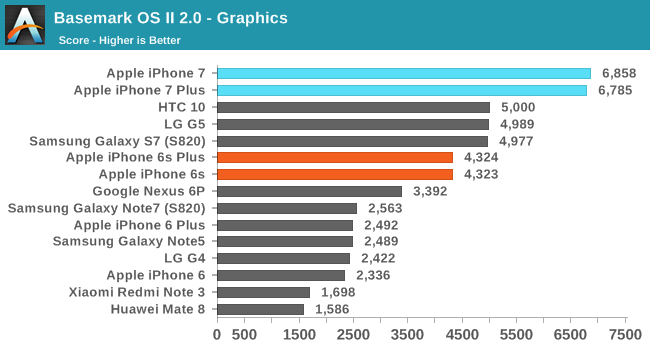
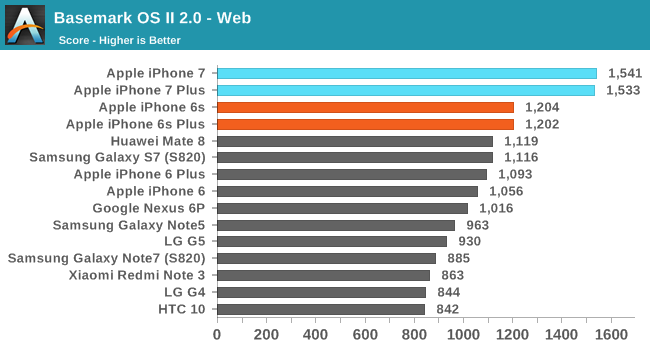

I've brought back BaseMark OS II for this review, although unfortunately the reason has less to do with wanting it back in the benchmark suite and more to do with there being very few cross-platform general system benchmarks nowadays. You can focus on the GPU, or the CPU, but the major system performance benchmark in mobile is PCMark and it remains exclusive to Android. BaseMark OS II is a pretty large optimization target now, and while it does test many aspects of the system it doesn't do so by directly simulating the tasks that a user would perform. Despite that, it helps in getting a holistic view of a device's performance by going beyond tests of a single component, so it's not without its uses.
The iPhone 6s and 6s Plus have remained the fastest overall devices in this test, so it's really just a matter of seeing how much Apple has improved. The latest generation of Android devices outpaced the GPU performance Apple's A9 SoC some time ago, so that's one area where Apple could stand to improve against the competition. As it turns out, they have. The iPhone 7 and 7 Plus show significant gains over their predecessors across the board. Performance in the system sub-test is up by 25-30%, and the graphics score is right in line with Apple's claimed 50% increase in performance. Web shows similar gains to system, which makes sense given that both are relatively CPU-bound.
The memory/storage test also shows a large improvement, which is interesting at first glance given that Apple didn't highlight any improvements in this area. However, this is just the result of the tested units being the 256GB model. On my retail iPhone 7 which is 128GB the memory score is essentially the same as the iPhone 6s which was also tested in a 128GB configuration. This comes down to the fact that these devices use a hybrid SLC/TLC storage solution, where the SLC storage can be used for writes and data can be moved later as needed. It's likely that on the 128GB iPhones the BaseMark OS II memory test is exceeding the size of the SLC cache, leading to lower scores based on the performance of the TLC NAND. On the 256GB iPhone the SLC cache is large enough to fit the entire data set used in the test, leading to a much higher score.
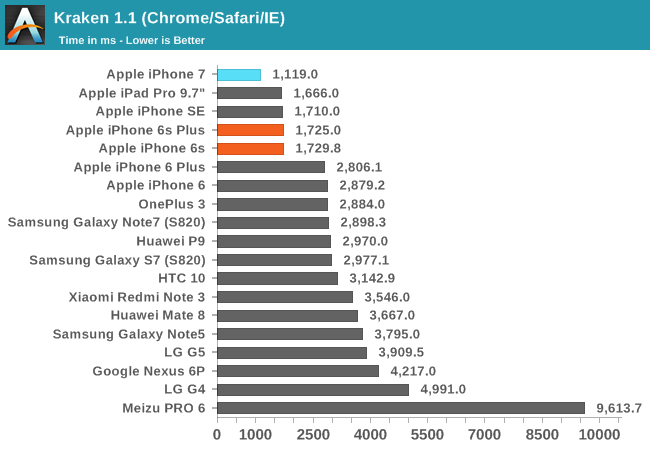
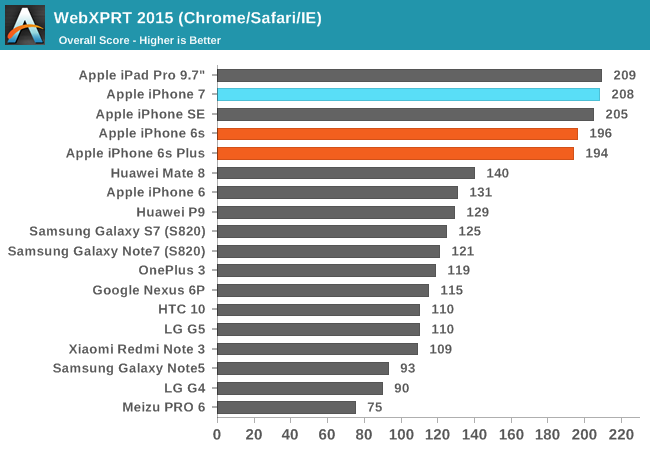
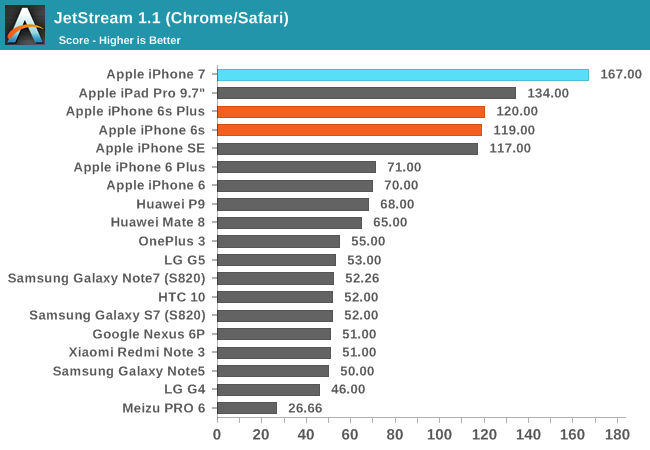
Web performance is an interesting case. While Apple's continued increases in single core CPU performance have benefited web performance with each generation, the truth is that improvements Mobile Safari's Nitro JavaScript engine have contributed a great deal as well. When looking at the charts you can see that there's a significant gap between the iPhone 7 and the next device, with the exception of WebXPRT where it's tied. What's more important than this gap is what the second device actually is. It's always another Apple device, and the same is true for the third device, and the fourth device, and so on. In Kraken and Jetstream the top seven devices on the chart are Apple's mobile devices, and the charts only have seven Apple devices in total. The Huawei Mate 8 is able to move ahead of the iPhone 6 in WebXPRT, but the gap between it and the iPhone 6s is still enormous. While Apple has continued to advance their web performance, it hasn't been with the immediate goal of beating the Android competition, as the best Android devices are still just trading blows with the iPhone 6.
WebXPRT is a small exception. As far as mobile benchmarks go, it's quite long and has short bursty workloads with pauses between each to simulate how a user would pause between different actions while using the browser. I suspect that in this case we're seeing the effects of A10 switching between its low power and high performance cores, causing parts of the test to be run on the little cores, which are not as performant. In fact, In the case of very quick actions that take only tenths or hundreths of a second to complete, it may not be possible to switch to the high performance cores before the operation has ended, causing the score to reflect the performance of the low power cores instead.
While it might seem reasonable to attribute the superior web performance of iOS devices to Apple's focus on improving single threaded CPU performance, the fact that Android devices with Cortex A72 CPUs are only matching Apple's A8 SoC shows that the gap is not only due to the CPU power available. Chrome's generally poor performance on Android is a significant limiting factor, and you can see in the chart how the improvement in Android device CPU performance over time has not translated into anything close to the sorts of gains that Apple has seen in the same period. While there are customized versions of Chromium like Snapdragon Browser that provide optimizations for a class of SoCs, it doesn't look like the gap between Android devices running Chrome and iOS devices running Mobile Safari is going to close any time soon, and if anything, it's only widening with each year.


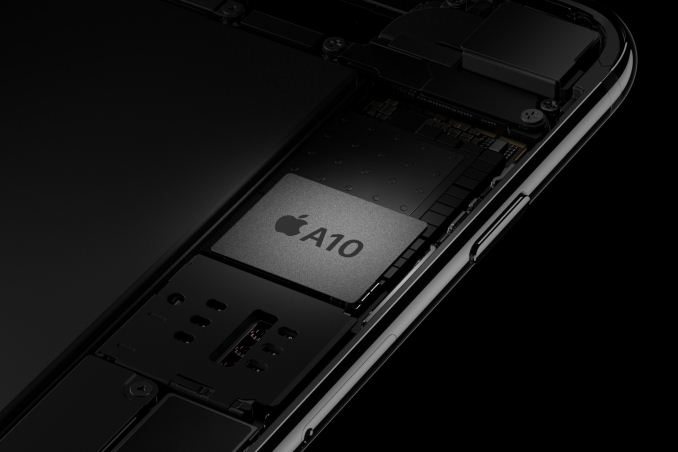








377 Comments
View All Comments
sweenish - Monday, October 10, 2016 - link
And if I had been waiting for an HTC 10 review? This iPhone review is nearly instantaneous by comparison.jtang97 - Tuesday, October 11, 2016 - link
Actually, this review came out about 5 times faster than the HTC 10.1 month compared to 5...
I'd say that that's an achievement. Add to the fact that it's a double phone review as well...
Affectionate-Bed-980 - Tuesday, October 11, 2016 - link
As a long time Anandtech reader one would notice the reviews are now standard 7 page affairs. Look at the iPhone 5 review and how Anand went in detail about CPU performance and power consumption. That kind of stuff doesn't happen anymore. And no offense Josh, taking a photo of a bush is pretty poor photography.We can't even compare against the Nexus phones. I understand some of this is challenging because different reviewers work on different parts of the review. I know Josh likes to take photos at UCLA whereas Brandon takes photos elsewhere, but it's very annoying I can't compare across all these phones because of that. You guys need to work something out for this. The same goes with benchmarks too and carrier tests. Maybe you guys need to standardize on reviewing GSM devices only and use a T-Mobile or AT&T SIM across the board.
dsumanik - Wednesday, October 12, 2016 - link
Wondering why "previous iPhone models had serious display variance' was not mentioned until now.IPhone shortcomings are only mentioned in the next generation device review. Hence I predict the iPhone 8 review will have the following statement
"with the iPhone 7 Apple made the move to remove the headphone jack, however they were not yet able to replace wired headphones on cost and quality. With the iPhone 8 I can safely say the issue is now moot"
Damn it's hard being right.
hans_ober - Saturday, October 15, 2016 - link
+1maher86 - Sunday, April 9, 2017 - link
Win the new iPhone 7- australia onlyhttps://www.youtube.com/watch?v=-RhV5wTcVJg&fe...
Wicasa - Monday, October 10, 2016 - link
Remember: "One-fifth of the people are against everything all the time."ddriver - Monday, October 10, 2016 - link
And the rest 4/5 are complacent sheeple that settle for anything.And judging by the responses, the "attention paying" skills of the status-quo are just as poor as expected, since I clearly didn't mean to complain about a "late review", but was rather making a point that when it is an iphone, the review is rather on time, at least relative to the AT standards of late.
dsumanik - Wednesday, October 12, 2016 - link
Dude the site is resting on the laurels of past achievements.The staff should be able to handle an iPhone review in one week or less.
But honestly I'll save you trouble, Tania going to recommend it to be the the best phone ever and must buy, like every other iPhone review.
If you want the real opinion you have to read between the lines in next years iPhone 8 review about all the problems the old device had.
Best bet make up your own damn mind.
No headphone jack, yet a fav exists onboard that is used with the adapter and onboard speakers.
Would u rather have a top mounted speaker or be able to use headphones, forced to buy expensive poor performing Apple licensed ones.
If wireless was the future beats would make wireless only, and they would be so much better that no one else bought wireless headphones anymore.
I'm mean after all the flip phone was replaced by a smartphone and wired headphones were replaced by...???
Expensive crap.
dsumanik - Wednesday, October 12, 2016 - link
The above comment was written on an iPhone 6s pretty iRonic an iPhone can't type a simple website comment ahahahahaha